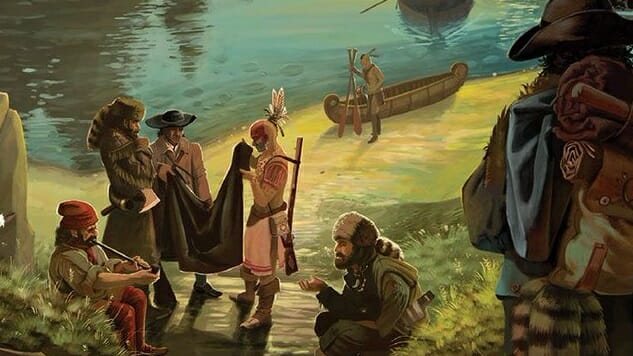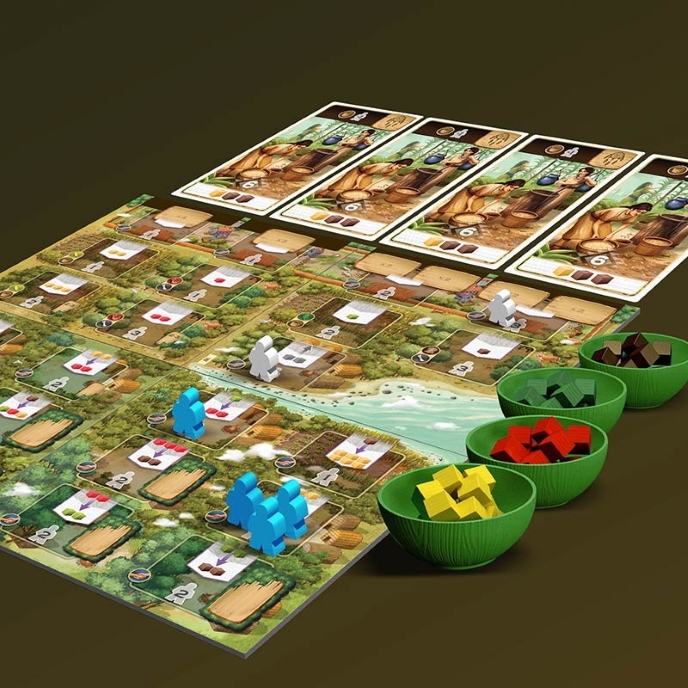
Emerson Matsuuchi’s trilogy of Century games, which began with 2017’s Century: Spice Road and continued with last year’s Century: Eastern Wonders, has now concluded with the brand-new Century: A New World, with each of the three games sharing one common mechanic and with rules that allow you to play any of the games on their own or in any combination of two or even all three. Each game offers a different twist on that common mechanic, but while Spice Road was elegant (and Splendor-like) in its simplicity, and Eastern Wonders ratcheted up the level of difficulty without becoming cumbersome, A New World might go a shade too far in its complexity.
All three games revolve around four trade goods, represented by yellow, red, green, and brown cubes, with increasing values (I listed them from lowest to highest), and in every one of the games you take some series of actions to upgrade whatever cubes you have to collect a set that you can trade in for an objective card that is worth some fixed number of victory points. In Spice Road, the entire game revolves around cards: it’s a basic hand management game, where you collect cards that allow for specific upgrades, trying to create a little engine of cards that you can run through over a series of turns, then “resting” for a turn to pick your played cards back up so you can do it all over again. In Eastern Wonders, you move around a map of hex tiles, each of which offered a specific upgrade action, but the game adds two layers: everyone plays on the same map, so you can end up blocked out of certain actions; and you can gain bonuses by visiting more tiles and building more of your trade stations. Both games play in 30-45 minutes, and turns are usually fairly quick.
A New World still has the four cubes and the core concept of upgrading your goods to buy victory point cards, but it does so in a worker placement game that adds at least four distinct new mechanics to the game. You start with six meeples—if you have young children or cats, be warned these meeples are very small—and can add more over the course of the game by buying certain cards, a bit reminiscent of Stone Age (sorry, there’s no “love shack” here). Only about half of the board is playable when the game starts; certain point cards also let the player who wins them remove an exploration tile from the board for some very modest bonus, which also opens up a new space for players to use. There’s a set collection mechanism, where each player can earn up to three bonus tiles that reward you for collecting cards with certain symbols on them—for example, you can get three points for every pair of cards where one shows a hammer and another bears a dreamcatcher. You may have to skip an occasional turn to retrieve all of your meeples from the board, but you may get one or more meeples back from other players’ moves; if someone wants to occupy the space you’re on, they can bump you by playing one more meeple than you have on that tile. The point cards also can give you certain bonus abilities, like gaining an extra cube on certain tiles, or allowing you to go to certain tiles with one fewer meeple (merson?) than the tile ordinarily requires.

With two players, A New World runs smoothly because you’ll rarely bump into each other; you will spend more turns taking your meeples back, but you’ll also rarely find yourself blocked from the action you want. With three or four, however, the board fills up more quickly, a competitive/interactive aspect that I found a bit frustrating because it simply meant waiting an extra turn to do what I needed to do. It also seems harder in A New World to get a real engine going, because you have no actual claim on any upgrade functions. In Spice Road, your cards are yours alone; in Eastern Wonders, you build a little pagoda on a tile you want to use, and then you can use it freely for the rest of the game. Here, there is no ownership of tiles, and no private upgrade function; you can plan a series of moves, but you’re at the mercy of the board.
Of the three games in the series, this is our least favorite. Spice Road is certainly the fastest to learn and fastest to play, while Eastern Wonders has a nice balance of the first game’s elegance and the last game’s goal of increasing the difficulty. The rewards in A New World also seem a bit paltry—for example, you can go through so much effort to collect the three or four cubes for a victory point card, and then all you get is 2-7 points. Some exploration tiles only get you a one-time bonus of two cubes, which seems meager compared to the two tiles that let you activate one of your six reserved meeples. It’s a fine game, but probably too fiddly for us to choose it over the preceding two titles in the series.
Matsuuchi has created multiple rule sets that allow you to combine any of the games in the Century line to play more ornate versions. There are seven games in all, including the three games on their own, three combinations of two, and the game that includes all three parts of the trilogy. The mega-game is still played primarily through the board from A New World, where players place meeples on the spaces on the map from this game, but with new map pieces that allow players to take actions on the Market (Spice Road) or a smaller map of island hexes (Eastern Wonders). The set collection and route optimization aspects of the earlier games are gone; you gain Merchant cards, but use them just once, and the map is small enough that route planning isn’t essential. Because each combination that includes A New World builds primarily off its worker placement aspect, I would prefer to stick to the first two titles, alone or together, rather than incorporate them into this third game.
Keith Law is a senior baseball writer for ESPN.com and an analyst on ESPN’s Baseball Tonight. You can read his baseball content at search.espn.go.com/keith-law and his personal blog the dish, covering games, literature, and more, at meadowparty.com/blog.